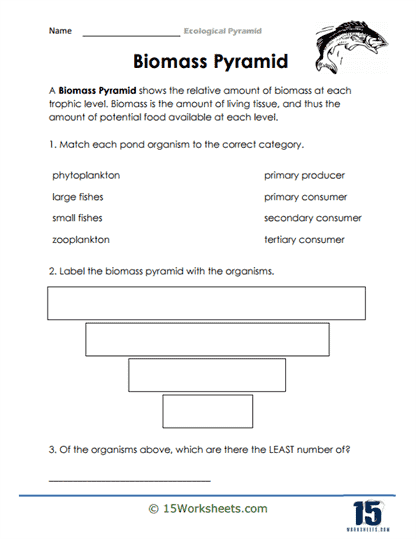Biomass Pyramid

Worksheet Description
A Biomass Pyramid shows the relative amount of biomass at each trophic level. Biomass is the amount of living tissue, and thus the amount of potential food available at each level. This worksheet asks you to match each pond organism to the correct category and then create an informal biomass pyramid.
This worksheet works off of a graphical representation that showcases the relative biomass amounts at different trophic levels within an ecosystem. Biomass refers to the total weight or mass of living organisms in a particular area, and it provides insight into the potential food available at each level. The sheet presents a list of pond organisms such as phytoplankton, large fishes, small fishes, and zooplankton, and challenges students to categorize them as primary producers, primary consumers, secondary consumers, or tertiary consumers. Following this categorization, students are then tasked with labeling a blank biomass pyramid with the previously categorized organisms and identifying which group has the least number.
To tackle this worksheet, students should commence by familiarizing themselves with the roles and definitions of primary producers, primary consumers, secondary consumers, and tertiary consumers. With this foundational knowledge, they can then match the provided pond organisms to their appropriate trophic level. Next, using their categorizations, students are to fill in the blank biomass pyramid, ensuring the organisms are correctly placed based on their trophic positions. Lastly, through observation and understanding of the ecosystem’s dynamics, they should determine which group of organisms is least abundant in number.
The primary objective of this worksheet is to foster an understanding of the principles underlying a biomass pyramid and the concept of trophic levels. It reinforces the idea that biomass decreases as one moves up the pyramid due to energy loss, reflecting the reduced weight of organisms at higher trophic levels. By categorizing and labeling pond organisms based on their roles in the food web, students gain a deeper appreciation for the interconnectedness of living beings within an ecosystem. Moreover, the exercise sharpens their analytical skills, training them to discern patterns and relationships within ecological structures.
